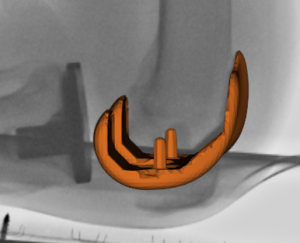Dr. Banks Lab

The main focus of our lab is to assist orthopaedic surgeons in their endeavors. Current projects include autonomous implant registration, gait analysis, and large animal medical imaging. Completed projects include soft-tissue 3D printing, dynamic x-ray scanning, series elastic actuator research, and surgeon interactive robotic imaging systems.
AI Biomechanics Lab (Dr. Costello)
Osteoarthritis (OA) is a degenerative joint disease that affects over 600 million people worldwide, with knee OA being the most common. Using OA as our focal point, our lab operates throughout the entire scope of joint health. In active individuals, we look at musculoskeletal injuries and sports biomechanics. For people diagnosed with OA, we study daily movement patterns in hopes to slow progression. And finally, for people with joint replacements, we analyze factors that might limit individual joint motion.
To understand how movement affects musculoskeletal/joint health, we need to account for all the individual factors that can affect movement (age, body size, prior injuries, etc.) and look at the multi-dimensional and time-varying patterns of movement that the body experiences in everyday life.
We utilize several different tools to capture movement during specific activities as well as patterns of physical activity during daily life, including markered and markerless motion capture, force platforms, wearable sensors (e.g., accelerometers, smart watches), and more. Computational resources, such as UF’s supercomputer, HiPerGator, and data analysis approaches such as machine learning, help us identify patterns among these different sources of information that are related to musculoskeletal/joint health outcomes.
Neuromechanics of Mobility Lab (Dr. Allen)
Daily life requires navigating diverse and complex demands, such as changing speeds, turning, and stepping over or around obstacles. Unfortunately, over a quarter of community-dwelling adults over the age of 65 and half of older adults with neurological deficits fall annually. A major focus in our lab is understanding how the nervous, muscular, and skeletal systems interact to maintain balance (or not!) while navigating these demands. To identify general principles underlying the control of balance during movement, our studies span the spectrum from motor expertise (e.g., ballet dancers) to motor impairment (e.g., stroke survivors). Through a comprehensive approach combining laboratory-based experiments, real-world monitoring, data science, and computational modeling, we aim to provide guidance for clinical decision-making and device design to improve mobility in daily life and mitigate the risk of falling.